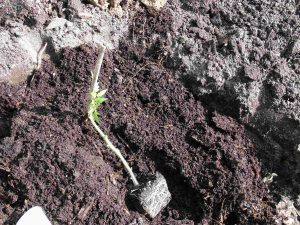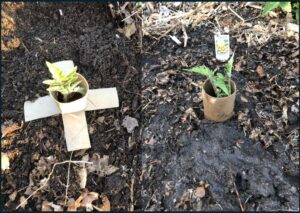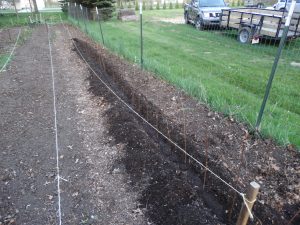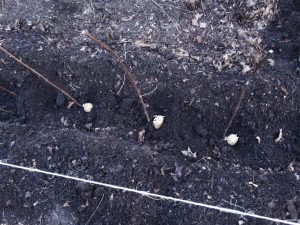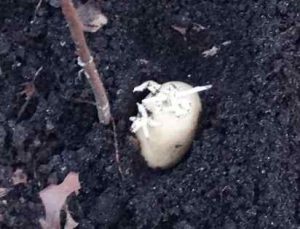Finally got the tomatoes in today. I buy plants from Weesie’s in Montague, Michigan. They do a great job with starting my tomatoes, peppers, and eggplants for me so I don’t have to worry about it.
One neat trick I’ve learned about tomatoes is to plant them up to their necks in the dirt. I use a similar method with eggplant and pepper transplants; but the entire stem of the tomato plant will grow roots if given the opportunity. Because of that, I’ve learned that planting them that way makes a much stronger plant. I put some pictures for examples below, you can click on each to get a better view.
I always start with a hole that I fill with compost. Usually go down about a foot, and the hole is a bit over a foot wide.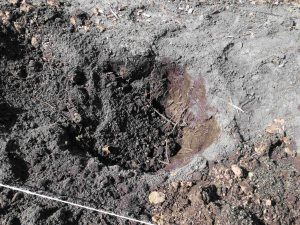
Next I take my plant and trim all but the very top set of leaves off. I use my fingernails, but if I don’t have nails I use the scissors that come with my Swiss army knife. Depending on how long the stem is, I either dig straight down into the compost and place the root ball in the bottom; or else I lay the plant at a slant with the root ball below the surface of the soil a few inches. The example below shows a small stick i used to lean the tip of the plant on so it will grow straight up.
After setting the plant where I want it, I cover all but the top set of leaves with soil. I let the leaves protrude from the surface a bit to allow room for the next and last step, the cutworm collar. I also water thoroughly at this point… and I’ll water again after the cutworm collar is in place.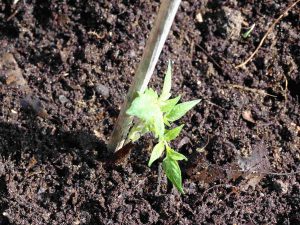
If you’ve ever transplanted something in the garden only to find it lying on the ground next to its stem a day or two later; you’ve been the victim of a cutworm’s naughty deed. These little buggers hide just beneath the soil, and if you find a plant that’s been whacked, it’s likely you can unearth the culprit very near the stem of the plant if you notice the damage quickly enough. I’ve had this happen once, and since then I’ve always protected tomato, pepper, and eggplant transplants with cutworm collars.
I make cutworm collars from toilet paper tubes. That’s right, toilet paper tubes! I start saving them in the fall until I have enough for what I think I’ll need. To make the collars, I cut slits into one half of the tube. Then I slide it over the plant so the leaves are just barely sitting over the top of the tube. To be effective against cutworms, I make sure the tube sits above the soil an inch (2.54 cm) or so. Then I anchor the tube by brushing soil over the flaps. Finally I take some soil and sprinkle it into the tube until it is at soil level (NOT all the way up). Anchoring the tube with soil is especially important to prevent the tube from being removed on windy days.
OK, done! Now to repeat the process for the remaining plants. These days I get fewer tomato plants and space them a little farther apart. I’m down to 6 plants now, and I space them about 2 “giant steps” apart. I grow a few different varieties for the fun of it. This year it’s Cherokee purple (one of my all time favorites), red cherry, red grape, Roma, and an heirloom variety called Stupice.
I’ve also been planting marigolds near tomatoes for some time. Marigolds help the tomatoes stay strong and the flowers are good for attracting bees.
Fun tip: I’ve been planting a few onion sets at the base of each tomato plants for several years now. Since I’ve been doing that, I have had very little disease and absolutely NO tomato worms.
Nothing beats a garden fresh tomato. Can hardly wait!!

